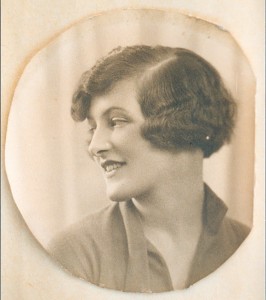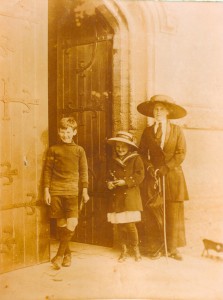Centenarians are less of a rarity than they used to be, but there are believed to be only eleven people in the U.K. who have survived their 110th birthday, witnesses to one of the most transformative periods in the whole history of mankind.
When Hermione Cock came into the world, the motor-car was still a rich man’s toy and the Wright brothers were only just poised to develop the first fixed-wing aircraft. She grew up in an English countryside where the horse was still dominant, recalled the shock of the Titanic disaster as if it were yesterday and experienced the terror of a Zeppelin raid. She took the jet-age in her stride, but felt that credit cards were only useful as ice-scrapers.
A certain disdain for the pace of innovation could be forgiven someone of her seniority. At the time of her recent death at Shrewsbury, aged 111 years and 237 days, she was the second oldest person in Britain and one of the world’s 50 or so authenticated ‘supercentenarians’.
She was born Hermione Hawkins on 1 March 1904, to a family of prominent Dorset farmers. Their holdings were at one time considerable, stretching from the outskirts of Dorchester almost to Chesil Beach. A relative, Catherine Hawkins of Waddon, had been Hardy’s inspiration for Bathsheba Everdene in Far From the Madding Crowd.
Hermione’s father, John (‘Jack’) Hawkins, was dashing, romantic and unconventional. A landless younger son, he had been recruited by Dr Cecil Reddie, founder of the ‘New School’, Abbotsholme, as its Gardening and Farming Master.
Abbotsholme, in Staffordshire, was a progressive boy’s school which encouraged ‘co-operation rather than competition’, and the Farming Master had a key role. All the boys were put to work on the school’s 140-acre farm, with classes suspended during haymaking. The rigours of Abbotsholme soon overwhelmed one of Jack Hawkins’s frailer pupils, Lytton Strachey, who barely survived two terms at the school.
The autocratic Reddie abhorred womankind in general, and refused to employ married men. With a newly acquired wife and son, Jack became agent to his cousin, John Ward, on his 3,800-acre Red Lodge estate at Braydon, Wiltshire. It was in the agent’s suitably home-spun residence, ‘The Bungalow’, that Hermione was born.
Her mother died a year later from the effects of a complicated birth. Hermione and her elder brother John, known as ‘Buster’, were brought up by their kindly maternal grandmother (an admiral’s daughter and niece of the 12th Earl of Huntingdon) and their two maiden aunts, Madge and Blanche Whicher, in a cottage in nearby Purton.
Hermione recalled a blissful rural childhood, the aunts reluctantly complying with Jack’s progressive views. On one occasion, he summarily removed from the person of his daughter several layers of petticoat that he deemed unnecessary.
He insisted, too, on their running around barefoot, though this was considered shameful by conventional Edwardians. In elementary schools at the time, a child turning up without shoes could expect to be caned; poverty was no excuse. Hermione vividly remembered an encounter with an angry passer-by, who denounced her negligent parenting and declared her blameless aunt Madge to be a ‘very wicked woman’.
Madge adored Jack and was a model of devotion and self-sacrifice, deferring her own marriage, to Colonel Albert Canning of Restrop House, until her sister was dead and she herself was 75. She loved the children as her own and took them to stay with their numerous relatives, including a nonagenarian great-aunt born in 1822.
Another pre-Victorian that Hermione knew was the Rev. Sabine Baring-Gould (born in 1834), the author of numerous best-selling books and the hymn ‘Onward Christian Soldiers’. Baring-Gould’s son had married their cousin, so the children were duly presented to him at Lew Trenchard, his manor-house on the edge of Dartmoor. On an inspection of his cabinet de curiosités, a back-scratcher consisting of a carved ivory hand on a stick was brought out and inserted under Buster’s shirt. To great consternation the stick emerged without the hand, which had become detached.
Jack, meanwhile, had returned to Abbotsholme, but his remarriage in 1914 obliged him again to resign. Installed on a farm in Derbyshire, he was in a position to reclaim his children, whose removal from the cottage in Purton was described by Hermione as ‘traumatic’.
Whilst Buster had proceeded from Abbotsholme to the Royal Naval College, Osborne, Hermione was sent to Bedales, ‘the noted school for the children of all the worst cranks in England’. Its founder-headmaster, John Haden Badley, had been Reddie’s right-hand man at Abbotsholme, but had not shared his aversion to women, and, indeed, had left in order to marry.
Unlike Abbotsholme, Bedales was a co-educational school, a concept that was deeply shocking to most people. Despite its liberal reputation, Hermione remembered that boys and girls were strictly segregated and that Badley, ‘the Chief’, imposed iron discipline.
As at Abbotsholme, the aim was to re-create a pre-industrial idyll, albeit at the expense of modern convenience and comfort. There was an insistence on daily cold baths, on keeping windows open in all weathers, on earth closets and, notoriously, on naked bathing in open cold water. The masters commonly wore beards and sandals, and a typical meal might consist of a banana.
Many, however, found the environment liberating and Hermione’s distinguished contemporaries included Frances Partridge, John Wyndham and Sir John Rothenstein. Her closest friend from Bedales was the Hampstead thinker, Margaret Gardiner.
Staying with the Gardiners in Kensington in 1917, Hermione was caught in a daylight Zeppelin raid and, underestimating the danger, hurried home with the younger children. Their angry father, Sir Alan Gardiner (the Egyptologist who later assisted Howard Carter in the opening of Tutankhamen’s tomb), instructed her in future to make for the nearest air-raid shelter.
In 1919, Jack Hawkins installed his family at Broom Hall, Shrewsbury, and in 1927, aged 23, Hermione married James Cock, whose family (originally Koch) ran a centuries-old tannery in Barker Street. The bridegroom wore spats, while Hermione had swathed a family veil round her face and ‘looked like a 14th-century nun. The most beautiful bride I ever saw,’ wrote her aunt. ‘She looked like an angel.’ The honeymoon was spent skiing in Chamonix, which in 1924 had hosted the first Winter Olympic Games.
The couple resided for a while with Jim Cock’s mother (Shrewsbury’s first woman mayor) at Cruckton Hall. The presence there of Jim’s ‘Uncle Ted’, the monocled former Home Secretary Sir Edward Shortt, guaranteed a permanent police guard. However, by the late 1930s they were settled with their three children in a large country house called The Grange, adjacent to the ruined Roman city at Wroxeter.
During World War II, while Jim served as an army officer in Africa, Hermione volunteered as a St John Ambulance nurse at the Shrewsbury Infirmary. The couple were married for nearly 57 years and lived in and around Shrewsbury for the rest of their lives. Hermione relished her regular trips to America to see their son.
Hermione had a remarkably calm, gentle and kindly nature and an artistic temperament, and was sustained by a deep faith. She spent her last years in a nursing home, piling up royal telegrams, but her longevity had become a curse, especially as her failing eyesight and hearing had left her increasingly isolated.
She came from a family of long-lived women, including her beloved aunt Madge, who died aged 99. Curiously, her fellow Bedalians, Frances Partridge and Margaret Gardiner, lived to 103 and 100 respectively. She is survived by her two daughters, and by many grandchildren and great-grandchildren. Her son and a granddaughter predeceased her.
Hermione Cock, supercentenarian, was born on 1 March 1904. She died on 24 October 2015, aged 111.

